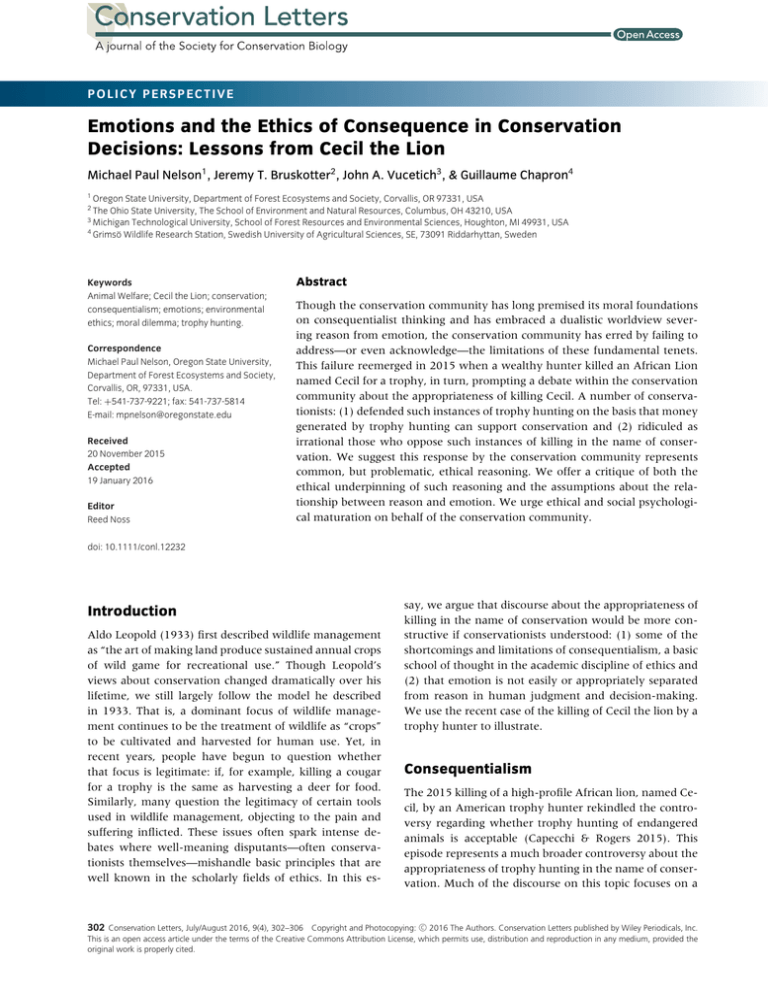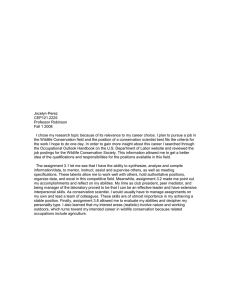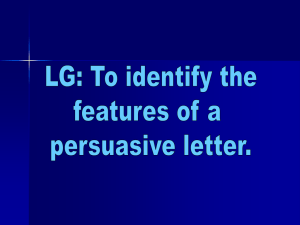Emotions and the Ethics of Consequence in Conservation Decisions
advertisement

POLICY PERSPECTIVE Emotions and the Ethics of Consequence in Conservation Decisions: Lessons from Cecil the Lion Michael Paul Nelson1 , Jeremy T. Bruskotter2 , John A. Vucetich3 , & Guillaume Chapron4 1 Oregon State University, Department of Forest Ecosystems and Society, Corvallis, OR 97331, USA The Ohio State University, The School of Environment and Natural Resources, Columbus, OH 43210, USA 3 Michigan Technological University, School of Forest Resources and Environmental Sciences, Houghton, MI 49931, USA 4 Grimsö Wildlife Research Station, Swedish University of Agricultural Sciences, SE, 73091 Riddarhyttan, Sweden 2 Keywords Animal Welfare; Cecil the Lion; conservation; consequentialism; emotions; environmental ethics; moral dilemma; trophy hunting. Correspondence Michael Paul Nelson, Oregon State University, Department of Forest Ecosystems and Society, Corvallis, OR, 97331, USA. Tel: +541-737-9221; fax: 541-737-5814 E-mail: mpnelson@oregonstate.edu Received 20 November 2015 Accepted 19 January 2016 Editor Reed Noss Abstract Though the conservation community has long premised its moral foundations on consequentialist thinking and has embraced a dualistic worldview severing reason from emotion, the conservation community has erred by failing to address—or even acknowledge—the limitations of these fundamental tenets. This failure reemerged in 2015 when a wealthy hunter killed an African Lion named Cecil for a trophy, in turn, prompting a debate within the conservation community about the appropriateness of killing Cecil. A number of conservationists: (1) defended such instances of trophy hunting on the basis that money generated by trophy hunting can support conservation and (2) ridiculed as irrational those who oppose such instances of killing in the name of conservation. We suggest this response by the conservation community represents common, but problematic, ethical reasoning. We offer a critique of both the ethical underpinning of such reasoning and the assumptions about the relationship between reason and emotion. We urge ethical and social psychological maturation on behalf of the conservation community. doi: 10.1111/conl.12232 Introduction Aldo Leopold (1933) first described wildlife management as “the art of making land produce sustained annual crops of wild game for recreational use.” Though Leopold’s views about conservation changed dramatically over his lifetime, we still largely follow the model he described in 1933. That is, a dominant focus of wildlife management continues to be the treatment of wildlife as “crops” to be cultivated and harvested for human use. Yet, in recent years, people have begun to question whether that focus is legitimate: if, for example, killing a cougar for a trophy is the same as harvesting a deer for food. Similarly, many question the legitimacy of certain tools used in wildlife management, objecting to the pain and suffering inflicted. These issues often spark intense debates where well-meaning disputants—often conservationists themselves—mishandle basic principles that are well known in the scholarly fields of ethics. In this es- say, we argue that discourse about the appropriateness of killing in the name of conservation would be more constructive if conservationists understood: (1) some of the shortcomings and limitations of consequentialism, a basic school of thought in the academic discipline of ethics and (2) that emotion is not easily or appropriately separated from reason in human judgment and decision-making. We use the recent case of the killing of Cecil the lion by a trophy hunter to illustrate. Consequentialism The 2015 killing of a high-profile African lion, named Cecil, by an American trophy hunter rekindled the controversy regarding whether trophy hunting of endangered animals is acceptable (Capecchi & Rogers 2015). This episode represents a much broader controversy about the appropriateness of trophy hunting in the name of conservation. Much of the discourse on this topic focuses on a C 2016 The Authors. Conservation Letters published by Wiley Periodicals, Inc. 302 Conservation Letters, July/August 2016, 9(4), 302–306 Copyright and Photocopying: This is an open access article under the terms of the Creative Commons Attribution License, which permits use, distribution and reproduction in any medium, provided the original work is properly cited. Michael Paul Nelson et al. key empirical question for conservation (i.e., can trophy hunting benefit a species or population?; Di Minin et al. 2016). But the discourse also tends to skirt the broader ethical question sitting at the heart of the controversy. This question, put simply, is—what constitutes a good reason to kill an animal? The Cecil episode also has direct policy implications because the U.S. Fish and Wildlife Service, which recently listed African lions under the U.S. Endangered Species Act (ESA), also created a special rule that allows for the importation of lion parts (normally illegal under the ESA) obtained in legal trophy hunts from countries with “scientifically based” harvest quotas (80 Fed. Reg. 80,016). Those who support trophy hunting rely primarily on two, oft-repeated, premises: (1) trophy hunting does not jeopardize the population and (2) trophy hunting can be useful, even necessary, for the species being hunted because it provides funding for their conservation (e.g., Di Minin et al. 2016). In addition to a rich academic literature both defending and challenging the empirical claim that trophy hunting benefits species and populations (e.g., Lindsey et al. 2007; Treves 2009), this issue has broad social interest as well. For example, an article published on National Geographic’s news site noted, “Supporters say regulated hunts raise much-needed money for conservation and help manage populations” and contends, “ . . . scientists can prove that the taking of select individuals will not endanger the species” (Howard 2015). Similarly, a piece published in the New York Times, noted hunting advocates “argue that, if done responsibly, the selling of expensive licenses to big-game hunters can help pay for efforts to protect endangered species” (Capecchi & Rogers 2015) and an article in The Conversation, authored by a pair of academic scientists, lends further support, arguing that “conservation costs money” and trophy hunting provides a means of funding conservation (Rust & Verissimo 2015). Looking across the coverage, the message is clear—though trophy hunting is extremely controversial, it is justified when it raises funding for conservation. These arguments presuppose an ethical theory called “consequentialism”—which posits that the consequences of one’s actions or a policy is the sole basis for judging whether they are right or wrong (consequentialism is invoked, for example, by the well-known aphorism, “the ends justify the means”). Consequentialist thinking is common in conservation (Gore et al. 2011). While the limitations of consequentialism are well known to ethicists, these shortcomings are less known to the conservation community. Below, we consider three of the most pertinent shortcomings. The first shortcoming is that in some cases the ends do not justify the means. Even if we grant that trophy hunt- Emotions and ethics in conservation decisions ing does not jeopardize the population of conservation concern and that it brings in significant funds for conservation, we are still left with the question, is the killing justified? This question cannot be dismissed simply by appealing to the beneficial consequences of the killing. Indeed, in many other human affairs we condemn actions or policies even if beneficial ends are obtained. For example, trafficking humans is taken to be a wrong way to treat humans even if doing so generates revenue that would be used for philanthropic purposes. The revenue that could be generated is not sufficient to override the wrong that is done when we condone human trafficking. The analogous questions need to be asked of trophy hunting in the name of conservation. A second shortcoming of consequentialism is its tendency to underappreciate the importance of motivation when determining the rightness or wrongness of an action. The importance of motivation in society is highlighted, for example, by the difference between manslaughter and murder—in those two cases, the moral culpability, the crime, and the punishment are all very different, even though the consequence of both crimes is exactly the same. Where trophy hunting is concerned, the motivations of the hunter are critical in determining the appropriateness of her or his actions. In the case of Cecil, the hunter was not motivated by the need for food or to protect himself, his family, his livestock, his pets, or his livelihood. The motivation for killing Cecil was recreation for the purpose of acquiring a trophy. The explosion of condemnation for this hunter’s actions is a testament to the fact that many people do not believe trophy acquisition is an appropriate motivation to kill (Decker et al. 2015). The controversy about the appropriateness of trophy hunting for conservation will likely persist until opponents are given good reason to believe that trophy hunting for conservation does not fall victim to these concerns about motivation. The importance of this concern is further indicated by controversies surrounding such practices as, for example, long-shot animal shooting (Petzal 2014), hunting that is tantamount to target practice (e.g., prairie dog shooting; Conniff 2013), and various wildlife killing contests (Bixby 2015). Finally, consequentialist approaches demand that we accurately predict future consequences of our actions and policies. The criticism here is blunt. Where the relationship between humans and nature is concerned, we simply are not very good at predicting the outcomes of our actions or policies (e.g., Holling & Meffe 1996). The concern applies to this particular case because our ability to reliably manage a trophy hunt without harming the population is far from certain (e.g., Whitman et al. 2004; Packer et al. 2009; Palazy et al. 2011). C 2016 The Authors. Conservation Letters published by Wiley Periodicals, Inc. Conservation Letters, July/August 2016, 9(4), 302–306 Copyright and Photocopying: 303 Emotions and ethics in conservation decisions Moreover, as a general principle, we tend to overestimate the benefits and underestimate the costs of our actions, especially when we are the beneficiaries of the action (Weinstein 1980; Sagoff 2004). This principle applies here insomuch as if one identifies with the basic and well-justified principles of animal welfare, then one is liable to underestimate the cost of harming a population and overestimating the cost of harming individuals; whereas if one identifies with the basic and well-justified principles of conservation, then one is liable to overestimate the cost of harming a population and underestimating the cost of harming individuals. Important antidotes to these shortcomings are reflected by the underlying principles of other ethical frameworks, such as deontology (Alexander & Moore 2015) and virtue theory (Hursthouse 2013). Indeed, judging whether the killing of endangered wildlife is justified requires analysis both of the consequences for the population (or species) and the individual organisms that are being killed, and the motivations and actions of the individual doing the killing. We urge the conservation community to consider these other ethical perspectives when deciding whether it should condone the various instances of killing in the name of conservation, including trophy hunting. Emotion In addition to a more sophisticated understanding of ethical perspectives (how we should behave with respect to wildlife), conservationists could also benefit from a more thorough understanding of psychological explanations of how people actually make judgments and decisions, especially the role of emotions. Some conservation professionals expressed support for Cecil’s killing, specifically, and trophy hunting, generally, while chastising those opposed as irrational or emotional. For example, one article chided, “While it is sad that we sometimes have to resort to killing animals for conservation, let’s not allow emotions to overtake our arguments” (Rust & Verissimo 2015). The notion that people oppose lethal actions because their judgment is clouded by emotion is, in our experience, common in conservation debates. Indeed, the idea that emotion is the opposite of, or antithetical to, reason dates back at least as far as Plato (Gardiner et al. 1937). However, research in psychology and neuroscience reveal flaws in this idea. This research indicates our deliberations and decision-making utilize both effortful, cognitive processes as well as quick, intuitive emotional processes (Greene et al. 2004; Kahneman 2011), and suggest that emotion can actually improve decision-making (Clark et al. 2008). Indeed, research on humans with damage to ventromedial prefrontal region of the brain (a region that assists with processing emotions) indicates that individuals with such damage Michael Paul Nelson et al. have difficulties making a variety of judgments and decisions (Bechara et al. 2000, 2004). Thus, while it may seem desirable to eschew emotion in decision-making, research suggests this may not be possible, let alone desirable. Psychological research indicates that the emotion of anger is a perfectly normal and healthy reaction to any of several kinds of perceived injustice (Batson et al. 2007, 2009). For example, we expect people to react angrily when they themselves are hurt by someone else’s actions. We expect and even encourage people to respond angrily when cared-for others are harmed, whether a child, friend, or even pet. Similarly, anger at a violation of a moral principle (e.g., do unto others . . . ), whether codified in law or scripture, is an appropriate response in a society dependent upon complex rules for maintaining order. Individuals who fail to respond with appropriate emotions (like empathy) when witnessing injustice, might be described as callous or antisocial. In fact, lack of empathy is associated with narcissistic personality disorder (Ritter et al. 2011) and a variety of aggressive, antisocial behaviors (Miller & Eisenberg 1988), while empathetic responses are associated with a variety of helping behaviors, including proenvironmental behavior (Schultz 2000; Berenguer 2007). Certainly, emotional outrage is sometimes no more than irrational lunacy (just as reason can at times turn into rationalization), and emotions can lead to less thoughtful, systematic processing of information (Wilson 2008). But often, emotional outrage is a reasonable (perhaps even “reasoned”) response to injustice and unfairness. Thus, although the eruption of emotional outrage is sometimes grounds for dismissing those who are outraged, it can also be a call for closer inspection for signs of injustice. (Note that we are in no way defending some of the clearly unvirtuous behavior exhibited by some opponents of trophy hunting in this case, who called for violence against Cecil’s killer; Capecchi & Rogers 2015.) Tools such as argument analysis (Nelson & Vucetich 2012) and conflict resolution (Madden & McQuinn 2014) can be useful for elucidating circumstances when emotions are, or are not, an appropriate response to some form of injustice. Where emotional responses appear inappropriate, decision-aiding tools that encourage thoughtful, systematic review of information can also be used to counteract emotional biases (Wilson 2008). Such methods can also prevent one from being overly attentive to emotions (e.g., attentive to the point of being inappropriately distracted from relevant facts or circumstances that merit attention). In any case, if the root cause of an emotional response is injustice, then the appropriate response is to address the injustice. There is increasing evidence to suggest that the public is becoming more empathetic toward wildlife (Manfredo et al. 2009), and people seem increasingly willing to C 2016 The Authors. Conservation Letters published by Wiley Periodicals, Inc. 304 Conservation Letters, July/August 2016, 9(4), 302–306 Copyright and Photocopying: Michael Paul Nelson et al. question conservation practices they view to be morally problematic. From a practical perspective, dismissing stakeholders’ views in an emotionally charged environment will almost certainly decrease trust among parties (Wilson 2008), and could undermine support for conservation initiatives. The key for conservation professionals is recognizing that emotion is not anathema to rational decision-making. Conclusion The Cecil case highlights the underappreciated importance of the human dimensions of conservation, in particular those pertaining to ethics and psychology. Trophy hunting as a means of conserving species is vigorously defended by some conservationists who implicitly rely on consequentialist ethical arguments. More than a century of scholarship in the field of ethics reveals flaws with consequentialism, calling into question conservation actions that rely solely on consequentialist arguments. The idea that emotion is the antithesis of rationality is also centuries old, and is employed as a means of dismissing people who display emotion in conservation debates. Yet, psychological research suggests emotional reactions to injustice are normal and healthy, and emotions can be critical for making “good” judgments and decisions. These new perspectives need not paralyze conservationists. As seen above, a variety of practical tools are available for assisting conservationists in understanding the ethical underpinnings of their positions, and for addressing the proper role of emotions in decision-making. References Alexander, L. & Moore, M. (2015). Deontological ethics. The Stanford Encyclopedia of Philosophy. http://www.plato. stanford.edu/entries/ethics-deontological/. Accessed November 1, 2015. Batson, C.D., Kennedy, C.L., Nord, L.A., et al. (2007). Anger at unfairness: is it moral outrage? Eur. J. Soc. Psychol., 37, 1272-1285. Batson, C.D., Chao, M.C. & Givens, J.M. (2009). Pursuing moral outrage: anger at torture. J. Exp. Soc. Psychol., 45, 155-160. Bechara, A., Tranel, D. & Damasio, H. (2000). Characterization of the decision-making impairment of patients with bilateral lesions of the ventromedial prefrontal cortex. Brain, 123, 2189-2202. Bechara, A. (2004). The role of emotion in decision-making: evidence from neurological patients with orbitofrontal damage. Brain and Cognition, 55, 30-40. Berenguer, J. (2007). The effect of empathy in proenvironmental attitudes and behavior. Environ. Behav., 39, 269-283. Emotions and ethics in conservation decisions Bixby, K. (July 31, 2015). Wildlife killing contests should be outlawed in the west. The Denver Post. http://www. denverpost.com/writersontherange/ci 27426211/ wildlife-killing-contests-should-be-outlawed-west Capecchi, C. & Rogers, K., (July 29, 2015). Killer of Cecil the lion finds out that he is a target now, of internet vigilantism, New York Times. http://www.nytimes.com/ 2015/07/30/us/cecil-the-lion-walter-palmer.html Clark, L., Bechara, A., Damasio, H., Aitken, M.R.F., Sahakian, B.J. & Robbins, T.W. (2008). Differential effects of insular and ventromedial prefrontal cortex lesions on risky decision-making. Brain, 131, 1311-1322. Conniff, R. (November 26, 2013). The brutal sport of prairie dog hunting. Takepart, on line at http://www.takepart. com/article/2013/11/26/brutal-sport-prairie-dog-hunting Decker, D.J., Stedman, R.C, Larson, L.R. & Siemer, W.F. (2015). Hunting for wildlife management in America. The Wildlife Professional, Spring, 26-29. Di Minin, E., Leader-Williams, N. & Bradshaw, C. (2016). Banning trophy hunting will exacerbate biodiversity loss. Trends Ecol. Evol. (E-published ahead of print). Gardiner, H.M., Metcalf, R.C. & Beebe-Center, J.G. (1937). The beginnings of a doctrine of the affections: from Heraclitus to Plato. Pages 1-25. Feeling and emotion: a history of theories. American Book Publishing, Salt Lake City, UT. Gore, M.L., Nelson, M.P., Vucetich, J.A., Smith, A. & Clark, M. (2011). Exploring the ethical basis for conservation policy: the case of inbred wolves on Isle Royale, USA. Conserv. Lett., 4, 394-401. Greene, J.D., Nystrom, L.E., Engell, A.D., Darley, J.M. & Cohen, J.D. (2004). The neural bases of cognitive conflict and control in moral judgment. Neuron, 44, 389-400. Holling, C.S. & Meffe, G. (1996). Command and control and the pathology of natural resource management. Conserv. Biol., 10, 328-337. Howard, B.C. (July 29, 2015). Can lion trophy hunting support conservation? National Geographic. http://www. news.nationalgeographic.com/2015/07/150729-liontrophy-hunting-conservation-animals-cecil/ Hursthouse, R. (2013). Virtue ethics. The Stanford Encyclopedia of Philosophy. http://www.plato.stanford.edu/entries/ethicsvirtue/ Kahneman, D. (2011). Thinking, fast and slow. Macmillan, New York. Leopold, A. (1933). Game management. Charles Scribner’s Sons, New York. Lindsey, P.A., Roulet, P.A. & Romañach, S.S. (2007). Economic and conservation significance of the trophy hunting industry in sub-Saharan Africa. Biol. Conserv., 134, 455-469. Madden, F. & McQuinn, B. (2014). Conservation’s blind spot: the case for conflict transformation in wildlife conservation. Biol. Conserv., 178, 97-106. C 2016 The Authors. Conservation Letters published by Wiley Periodicals, Inc. Conservation Letters, July/August 2016, 9(4), 302–306 Copyright and Photocopying: 305 Emotions and ethics in conservation decisions Manfredo, M.J., Teel, T.L. & Henry, K.L. (2009). Linking society and environment: a multilevel model of shifting wildlife value orientations in the western United States. Soc. Sci. Quart., 90, 407-427. Miller, P.A. & Eisenberg, N. (1988). The relation of empathy to aggressive and externalizing/antisocial behavior. Psychol. Bull., 103, 324. Nelson, M.P. & Vucetich, J.A. (2012). Environmental ethics and wildlife management. Pages 223-237 in D.J. Decker, S.J. Riley, W.F. Siemer, editors. Human dimensions of wildlife management, 2nd ed. Johns Hopkins University Press, Baltimore. Packer, C., Kosmala, M., Cooley, H.S. et al. (2009). Sport hunting, predator control and conservation of large carnivores. Plos One, 4, e5941. Palazy, L., Bonenfant, C., Gaillard, J.M. & Courchamp, F. (2011). Cat dilemma: too protected to escape trophy hunting? PloS One, 6(7). Petzal, D.E. (August 27, 2014). The line between hunting and long-range shooting. Field and Stream. http://www.fieldandstream.com/blogs/the-gun-nuts/theline-between-hunting-and-long-range-shooting Michael Paul Nelson et al. Ritter, K., Dziobek, I., Preibler, S., et al. (2011). Lack of empathy in patients with narcissistic personality disorder. Psychiat. Res., 187, 241-247. Rust, N. & Verissimo, D. (July 29, 2015). Why killing lions like Cecil may actually be good for conservation, The Conversation. https://www.theconversation.com/whykilling-lions-like-cecil-may-actually-be-good-forconservation-45400 Sagoff, M. (2004). Price, principle, and the environment. Cambridge University Press, Cambridge. Schultz, P.W. (2000). Empathizing with nature: the effects of perspective taking on concern for environmental education. J. Soc. Issues, 56, 391-406. Treves, A. (2009). Hunting for large carnivore conservation. J. Appl. Ecol., 46, 1350-1356. Weinstein, N.D. (1980). Unrealistic optimism about future life events. J. Personality Soc. Psychol., 39, 806-820. Wilson, R.S. (2008). Balancing emotion and cognition: a case for decision aiding in conservation efforts. Conserv. Biol., 22(6), 1452-1450. Whitman, K., Starfield, A.M., Quadling, H.S. & Packer, C. (2004). Sustainable trophy hunting of African lions. Nature, 428, 175-178. C 2016 The Authors. Conservation Letters published by Wiley Periodicals, Inc. 306 Conservation Letters, July/August 2016, 9(4), 302–306 Copyright and Photocopying:




